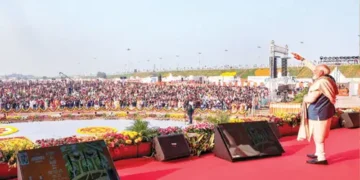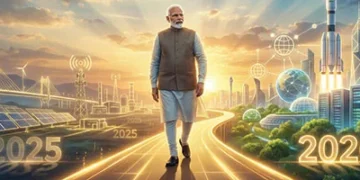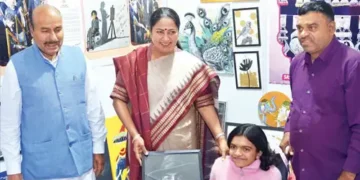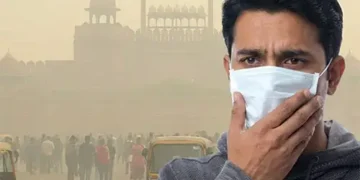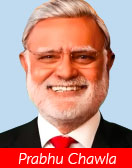 The vice-presidency, once the Republic’s quiet conscience, is now its loudest cockpit. From a sanctified sanctum of sobriety and sagacity, it has degenerated into a dramaturgical amphitheatre of ideological antagonism, caste cartography, and regional recalibration. What was formerly the perch of philosopher-statesmen and constitutional custodians has metastasised into a platform for partisan praetorians, electoral emissaries, and ideological incendiaries. The chair that once epitomised equipoise has been transfigured into a stage of confrontation. The 2025 vicepresidential contest is not a procedural prosaic – it is a pupa of political metamorphosis.
The vice-presidency, once the Republic’s quiet conscience, is now its loudest cockpit. From a sanctified sanctum of sobriety and sagacity, it has degenerated into a dramaturgical amphitheatre of ideological antagonism, caste cartography, and regional recalibration. What was formerly the perch of philosopher-statesmen and constitutional custodians has metastasised into a platform for partisan praetorians, electoral emissaries, and ideological incendiaries. The chair that once epitomised equipoise has been transfigured into a stage of confrontation. The 2025 vicepresidential contest is not a procedural prosaic – it is a pupa of political metamorphosis.
This year’s confrontation, like its predecessors, dramatises the dialectic of two Indias. NDA, with deliberate dramaturgy, has unfurled CP Radhakrishnan: an inveterate RSS swayamsevak of impeccable integrity from Tamil Nadu. His candidature is no ceremonial cipher; it is a strategic subterfuge designed to destabilise Dravidian dogma and insinuate the ideology of centralised nationalism into the southern terrain.
In contrast, the INDIA bloc has Justice B Sudershan Reddy, a juristic luminary, an upper caste by birth, but liberal by leaning, whose bench-burnished reputation evokes civil liberty, constitutional morality, and jurisprudential conscience. To his proponents, he is the face of Nehruvian rationalism and a protector of the Naxal movement. To the Sangh, he is the quintessence of ‘judicial adventurism’, an avatar of ‘activist overreach’, a juridical Jacobin who imperilled security in the name of sophistic legality.
Thus, the duel is more a battle of archetypes, a confrontation of cultural cosmogonies: one privileging homogenised nationalism, the other heralding pluralist liberalism.
Institutional interlocutor
Why, one may ask, such febrile fervour for an ostensibly ornamental office? Because the Vice-President presides over the Rajya Sabha, the institutional interlocutor between unbridled majoritarianism and constitutional moderation. In an epoch where the Lok Sabha has become an assembly line for legislative bulldozers, the Rajya Sabha endures as the last rampart of resistance. A supine Vice-President can lubricate legislative leviathans; a principled one can thwart authoritarian audacity. Hence, the office transmutes from ceremonial to consequential, from symbolic to strategic.
In the pristine decades of the Republic, Vice-Presidents were chosen through consensus, embodying gravitas rather than grubby partisanship. Sarvepalli Radhakrishnan, Zakir Husain, Gopal Swarup Pathak were all elevated unopposed, exemplars of equilibrium and erudition. But Indira Gandhi inaugurated the era of instrumentalism, preferring loyalty over legacy and compliance over conscience. Thereafter, caste, creed, and constituency became the metres of choice. The role has gained strategic importance precisely because the ruling regime increasingly sees Parliament not as a forum for dialogue, but as an assembly line for legislation.
As successive governments bulldoze key Bills through the Lok Sabha with brute majority, the Rajya Sabha has become the final frontier of democratic virtue. In such a context, the Vice-President’s control over the Upper House becomes a tool of either suppression or salvation, depending on who occupies the chair. And herein lies the BJP’s motivation: a neutral arbiter would be a speed bump; a fellow traveller would be a catalyst.
Sociological syllabus
The roster of Vice-Presidents reads like a sociological syllabus: Brahmin, Dalit, Muslim, Lingayat, Jat, Kayasth, Kamma. Each election encoded a cultural calculus; each defeat disclosed a deeper dissonance – Shinde vs Shekhawat (Dalit vs Rajput), Heptulla vs Ansari (Muslim diversity vs Muslim diplomacy), Alva vs Dhankhar (Christian minority vs Hindu majoritarianism). Now, in 2025, the dialectic continues: Tamil saffron vs Telugu jurisprudence; Stalinist federalism vs Sangh centralism; Nehruvian conscience vs nationalist consolidation.
Equally revealing is the gallery of those who lost. And each contest tells a story. In 2002, the UPA chose Sushil Kumar Shinde, a prominent Dalit face from Maharashtra, to take on Bhairon Singh Shekhawat, a tall Rajput leader from Rajasthan and a BJP veteran. The contest laid bare the caste lines – with the Congress attempting to consolidate Dalit sentiment, while the NDA banked on upper caste dominance. In 2007, the NDA reversed the narrative: it fielded Najma Heptulla, a Muslim woman, against fellow Muslim Hamid Ansari, a career diplomat, Vice-Chancellor, and someone with deep ties to academic and foreign service institutions. The choice was deliberate since NDA sought to project diversity while countering UPA’s institutional liberalism.
Unmissable symbolism
The trend continued in 2022, when the UPA put forward Margaret Alva, a senior Christian woman leader from Karnataka. The symbolism was unmissable—gender, minority, region were all bundled into one candidature. Alva faced Jagdeep Dhankhar, a Jat from Rajasthan and a known Modi loyalist. The result was emphatic: Dhankhar won by a margin of 346 votes. But the subtext was larger than the score line. The BJP had once again asserted control over the House of Elders. The caste equation, once used to balance representation, is now often used to divide and disrupt opposition unity. In 2025, that story continues. The contest is layered.
It pits a liberal legal mind against a loyal ideological worker. The South is at a crossroads: will Tamil pride accept a BJP man, or will Andhra loyalty bow before central diktats? The BJP has the edge in Parliament and allies, even if reluctant, may toe the line. But the subtext is louder than the result. The symbolism of this contest – RSS vs Nehruvism, Tamil vs Telugu, and Stalin vs Sangh – is inescapable. The vice- presidency is caught in the larger struggle between homogenisation and heterodoxy, between control and conscience. INDIA is banking on Sudershan Reddy’s regional identity to force a rift in the NDA ranks. Conversely, NDA expects the opposition’s hesitation about a conservative Tamil RSS man to split the secular camp. These are not candidates; they are chess pieces. The game is federal fragmentation.
Political culture
This election is also a verdict on political culture. The rise of partisan Vice- Presidents like Hamid Ansari and Jagdeep Dhankhar, whose confrontations with opposition members were frequent, signals a new normal. The chair is no longer neutral. The Rajya Sabha, a House for deliberation, suffers the most if its proceedings are steered by a chairman who is blindly beholden to power, not principle. India’s democracy, battered by this spectacle, cries for a Vice-President who rises above caste and creed, not one mired in their quicksand.
This election is a confrontation between homogenisation and heterodoxy, between constitutional conscience and majoritarian might. The Upper House teeters on a dilemma: is its chair a custodian of conscience or a commissar of compliance? In 2025, as MPs cast their votes, they are not merely electing a Vice-President. They are adjudicating between two metaphysical visions of India – one hegemonised by monolithic majoritarianism, and the other animated by hyped pluralist possibility. When the VicePresident becomes a vassal, the Republic itself becomes a relic.
Thus, from S Radhakrishnan to Reddy, from philosophy to fragmentation, the office of Vice-President has undergone a slow degeneration. Not because the individuals are less capable, but because the criterion for selection has shrunk from excellence to expedience. A nation that once looked to the vice-presidency for vision, now uses it to send signals – to caste groups, to regions, to restless coalitions. The second-highest constitutional office in India has become the second-most symbolic seat – hardly honoured, largely hollowed.















